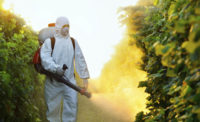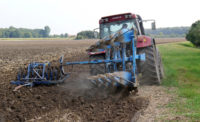New research from North Carolina State University connects several pesticides commonly used by farmers with both allergic and non-allergic wheeze, which can be a sensitive marker for early airway problems.
Only men used in study
NC State epidemiologist Jane Hoppin and colleagues from the National Institute of Environmental Health Sciences (NIEHS), the National Cancer Institute, Westat and the National Institute for Occupational Safety and Health (NIOSH) used interview data from the 2005 – 2010 Agricultural Health Study (AHS) to evaluate the association between allergic and non-allergic wheeze and 78 pesticides. The AHS is a longitudinal study of farmers and their spouses in Iowa and North Carolina. For the purposes of this analysis, the researchers only used data from the male farmers.
In the current study, 22,134 farmers reported which pesticides they had used in the last year, and specific respiratory symptoms they had experienced. Allergic wheeze was defined as reporting both wheezing and doctor-diagnosed hay fever, while non-allergic wheeze was defined as reporting wheezing but no hay fever. The researchers used this information in statistical models to compare the control group – farmers who had never used the pesticide in question – to those who had used it, and to compare the frequency of either allergic or non-allergic wheeze.
Dozens of pesticides studied
The 78 pesticides included 45 herbicides and plant growth regulators, 25 insecticides, six fungicides, one fumigant and one rodenticide. Of the 78 assessed, 29 were associated with at least one type of wheeze: 19 were significantly associated with allergic wheeze, 21 with non-allergic wheeze and 11 were significantly associated with both.
In the herbicide group, 18 were associated with at least one wheeze outcome, 14 with non-allergic wheeze and 10 with allergic wheeze. Glyphosate, the most commonly used herbicide in the world, was associated with both types of wheeze. Interestingly, the less commonly used herbicide glufosinate ammonium was not associated with either type of wheeze.
In the insecticide group, nine of the 25 were associated with at least one type of wheeze. Permethrin and pyrethrins were associated with both types of wheeze. And in the fungicide, fumigant and rodenticide group, none were associated with non-allergic wheeze, and only the rodenticide warfarin was associated with allergic wheeze.
Residential use as well
“This is the most comprehensive list of pesticides in relation to wheeze that has been evaluated to date,” Hoppin says. “Fifty-one of the pesticides we tested in this study had never been analyzed in terms of their effects on respiratory outcomes. And some of them, like glyphosate, 2,4-D and permethrin, aren’t just used on farms. They’re used residentially now to kill weeds or treat fleas on pets. We believe it’s important information that will help people make decisions about pesticides.”
The research appears in Environmental Health Perspectives. Co-authors include David Umbach, Stephani London and Dale Sandler from the NIEHS, Stuart Long of Westat, Paul Henneberger of NIOSH, and Aaron Blair, Michael Alavanja and Laura Beane Freeman of NCI. NIEHS grant Z01-ES025041 and NCI grant Z01-CP010119 provided funding for the work.









